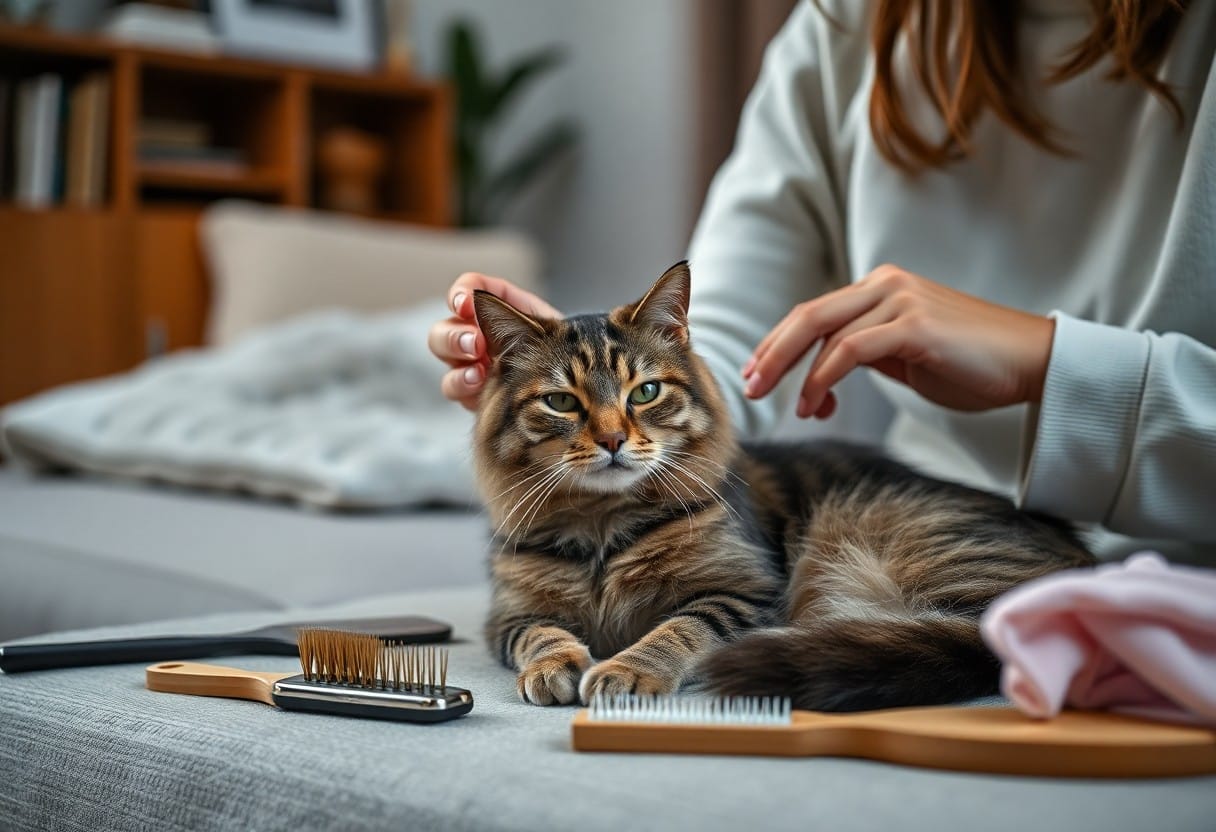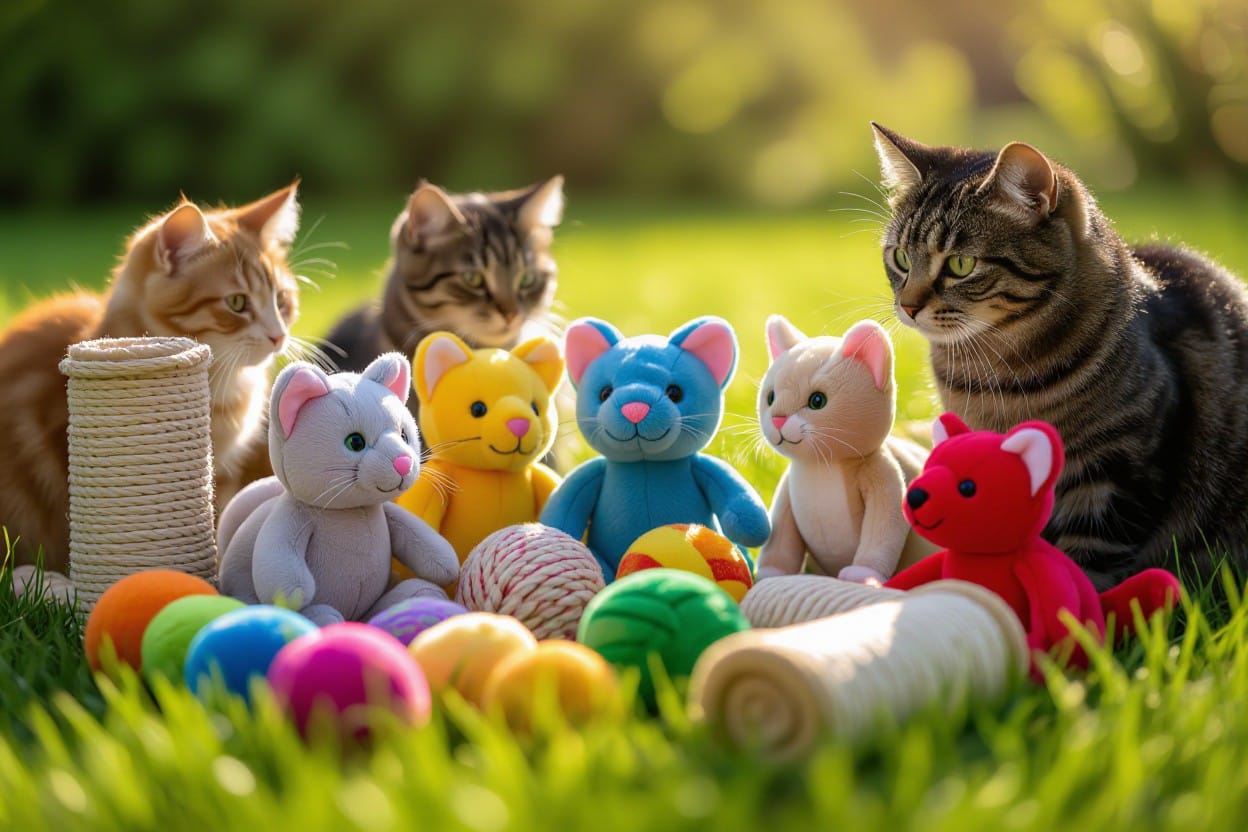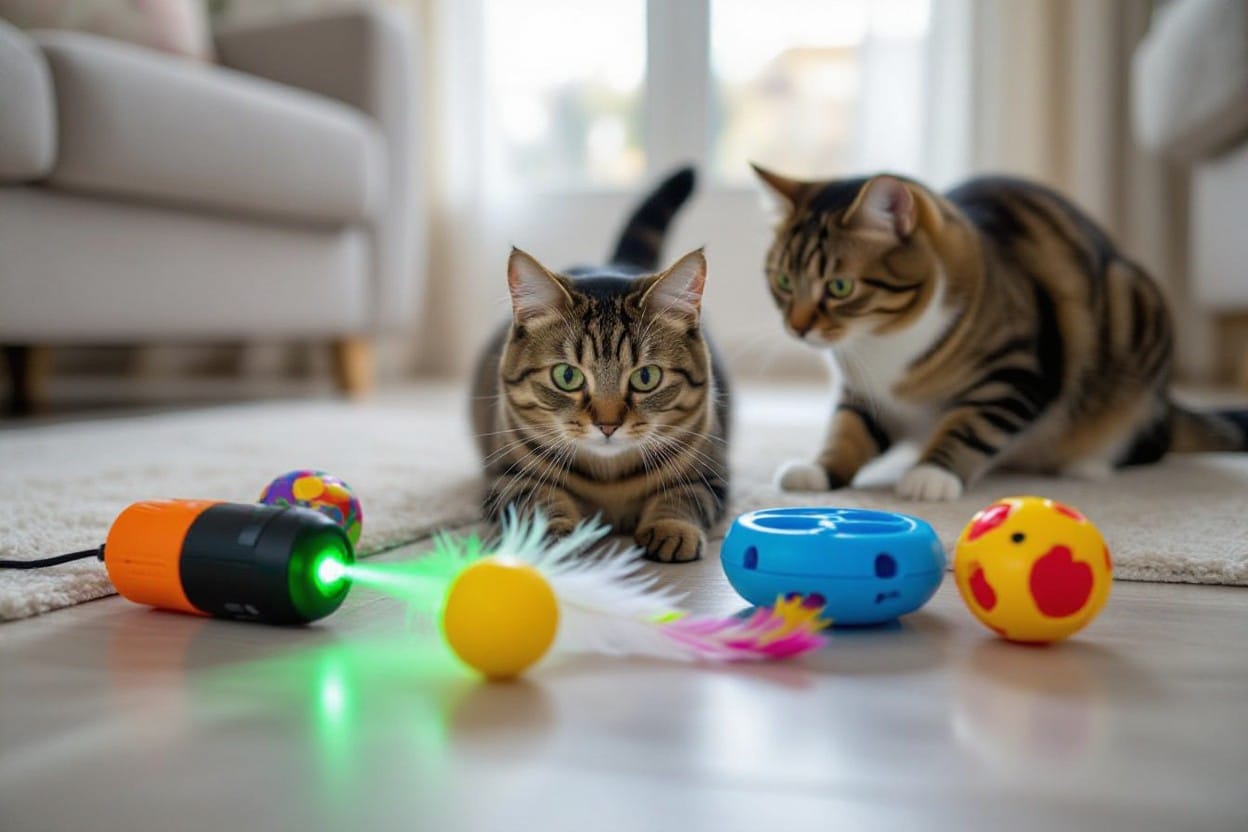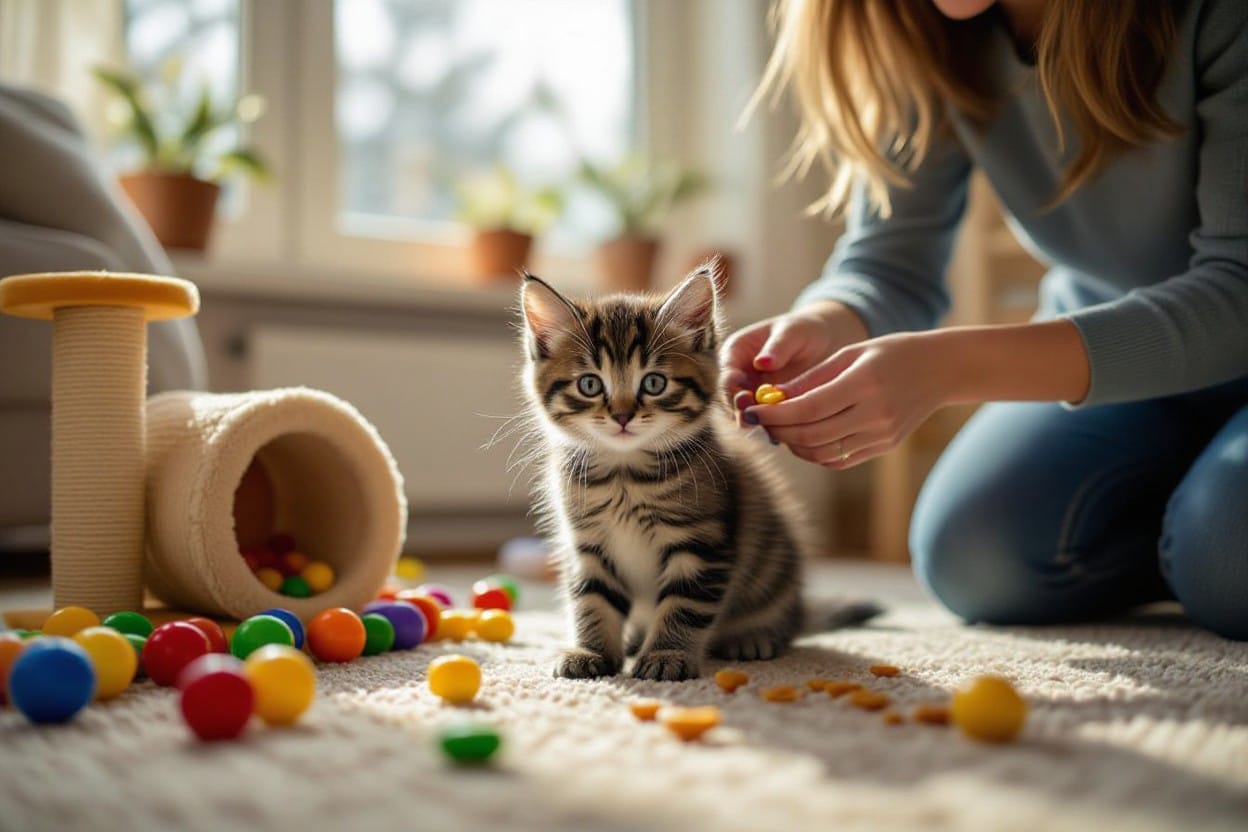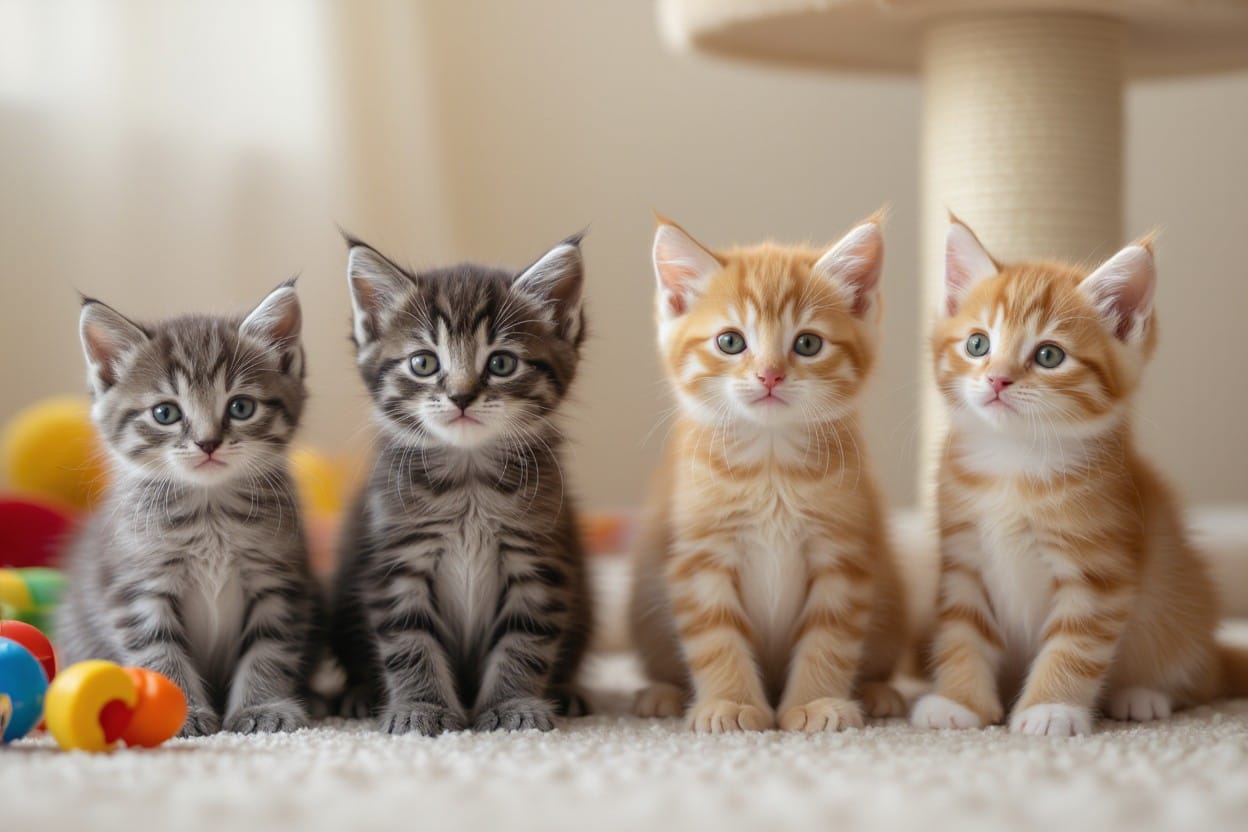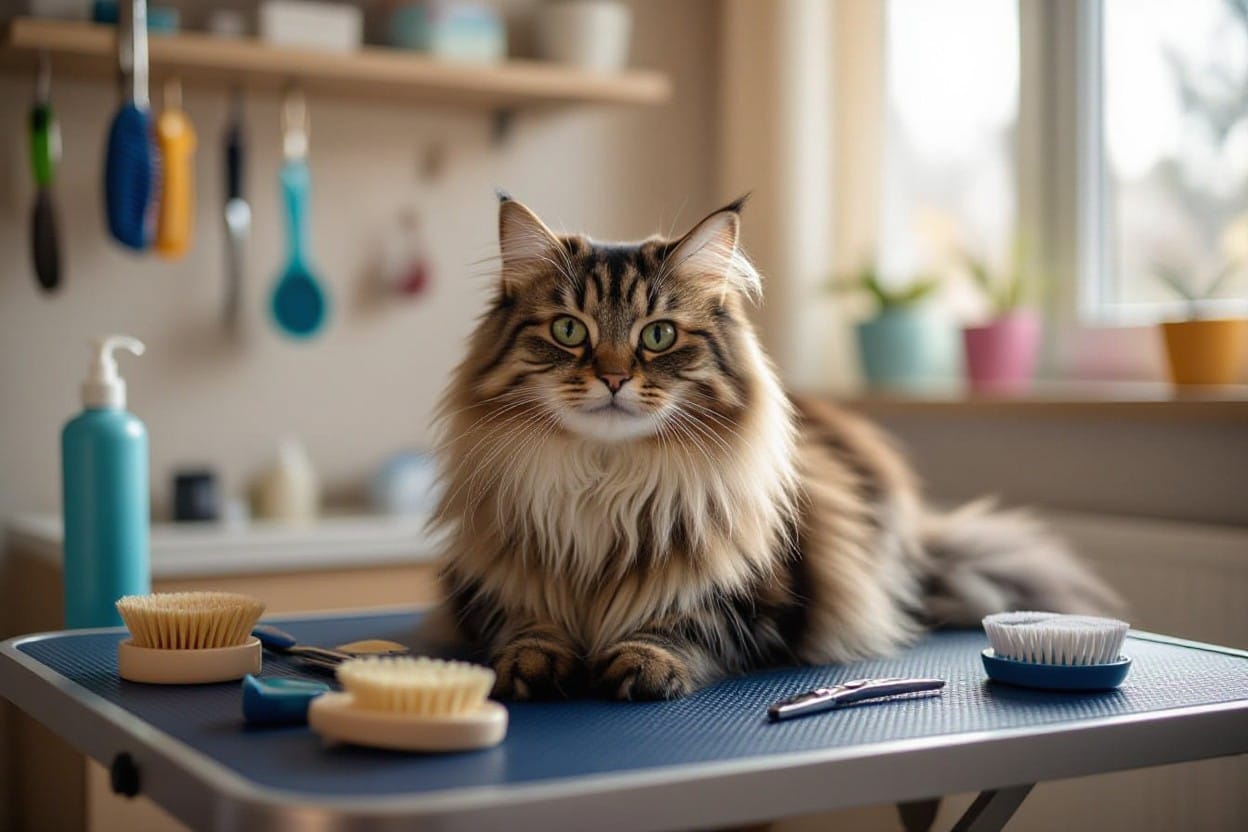Grooming your cat can be a rewarding experience when approached correctly. You have the power to transform it into a calming ritual by creating a soothing environment and using gentle techniques. This guide will provide you with effective tips to ensure that both you and your feline friend feel safe and comfortable during the process. By understanding your cat’s needs and responses, you can help prevent stress and build trust, making grooming a time of connection rather than a struggle.
Key Takeaways:
- Establish a calm environment by using gentle voices and soft music to help your cat feel more at ease during grooming sessions.
- Use the right tools, such as a soft brush or grooming gloves, to create a positive experience and avoid discomfort for your cat.
- Schedule regular grooming sessions to gradually build your cat’s comfort and trust, making the process more enjoyable for both of you.
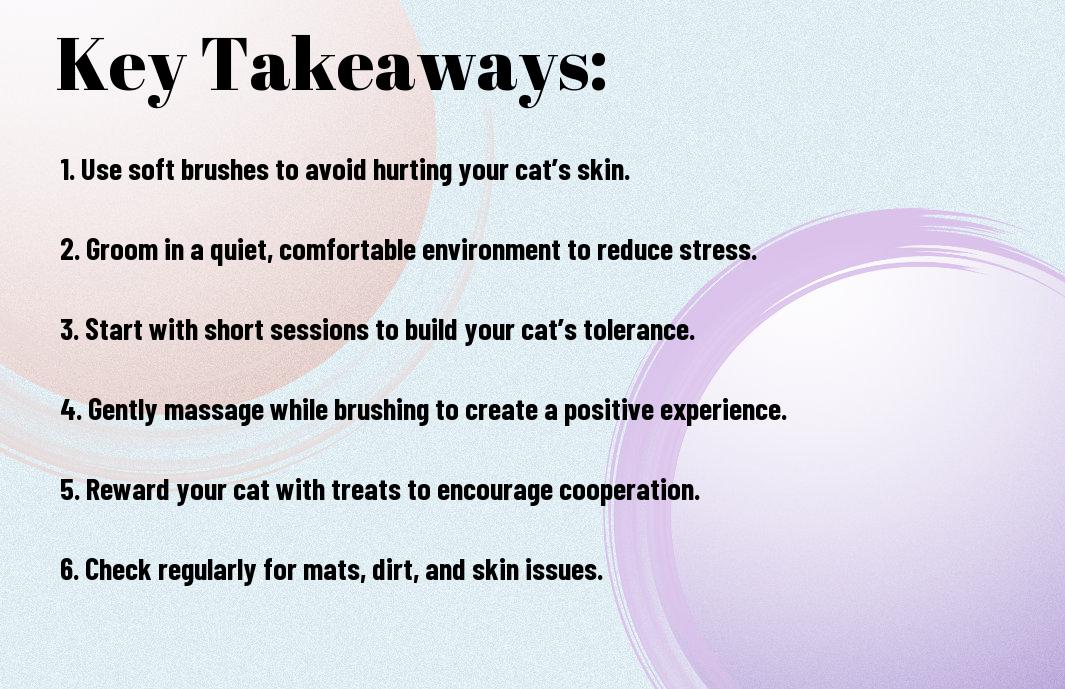
Understanding Your Cat’s Grooming Needs
A gentle approach to grooming starts with understanding your cat’s individual grooming needs. Each cat is unique, and their grooming requirements can vary based on factors such as breed, age, and health. By identifying these needs, you can create a relaxing grooming routine that ensures your cat remains comfortable and happy.
Different Coat Types
One way to assess your cat’s grooming needs is by recognizing their coat type. Each type has specific requirements that affect grooming frequency and technique:
| Short Hair | Minimal grooming, brush weekly to reduce shedding. |
| Medium Hair | Brush every other day to prevent mats. |
| Long Hair | Daily brushing to avoid tangles and mats. |
| Curly Hair | Needs specific brushes, groom regularly to maintain texture. |
| Hairless | Requires skin care routine, wipe down regularly. |
- Short Hair cats may require minimal grooming.
- Medium Hair cats benefit from regular brushing.
- Long Hair cats need daily attention to avoid mats.
- Curly Hair breeds need special care.
- Hairless cats necessitate skin maintenance.
Assume that knowing your cat’s coat type can significantly enhance your grooming experience.
Recognizing When Grooming is Necessary
To keep your cat looking its best, it’s important to recognize when grooming is necessary. Factors such as shedding season, matting, and dirt can indicate that it’s time for a grooming session. Regular checks on your cat’s coat and skin condition will help you determine their grooming needs effectively.
And don’t overlook the signs that may indicate your cat needs more frequent grooming. Watch for excessive shedding, which can lead to hairballs, or matted fur that can cause skin irritations. Pay attention to dirt buildup or odor as these may suggest a bath is needed. Being proactive about your cat’s grooming not only keeps them looking great but also promotes their overall health and well-being.
Creating a Comfortable Grooming Environment
One of the keys to successful cat grooming at home is establishing a comfortable environment that helps your feline friend feel safe and relaxed. This can significantly impact the grooming experience, reducing stress for both you and your cat. Consider utilizing a quiet area with minimal distractions, soft surfaces, and familiar scents. Using positive reinforcement, such as treats or gentle petting, can also create a positive atmosphere that encourages cooperation during grooming sessions.
Setting Up the Space
Space is necessary for a pleasant grooming session. Choose a location that is quiet, free from sudden noises, and holds familiar scents for your cat. If possible, set up a designated grooming station with all your necessary tools within reach. Adding a cozy blanket or a pillow can make the area inviting, promoting a sense of safety for your cat. The right space sets the tone for a positive grooming experience.
Choosing the Right Time
Choosing the right moment for grooming can significantly enhance your cat’s comfort and cooperation. Aim for a time when your cat is generally calm and relaxed, such as after a meal or during their favorite napping hours.
Environment is critical; if your cat is feeling playful or restless, pushing a grooming session can lead to frustration for both of you. Observe your cat’s behavior to identify when they are most at ease. Additionally, avoid grooming during busy times or when high levels of activity are present in the household. You’ll set yourself up for a smoother experience by aligning your grooming sessions with their natural rhythms.
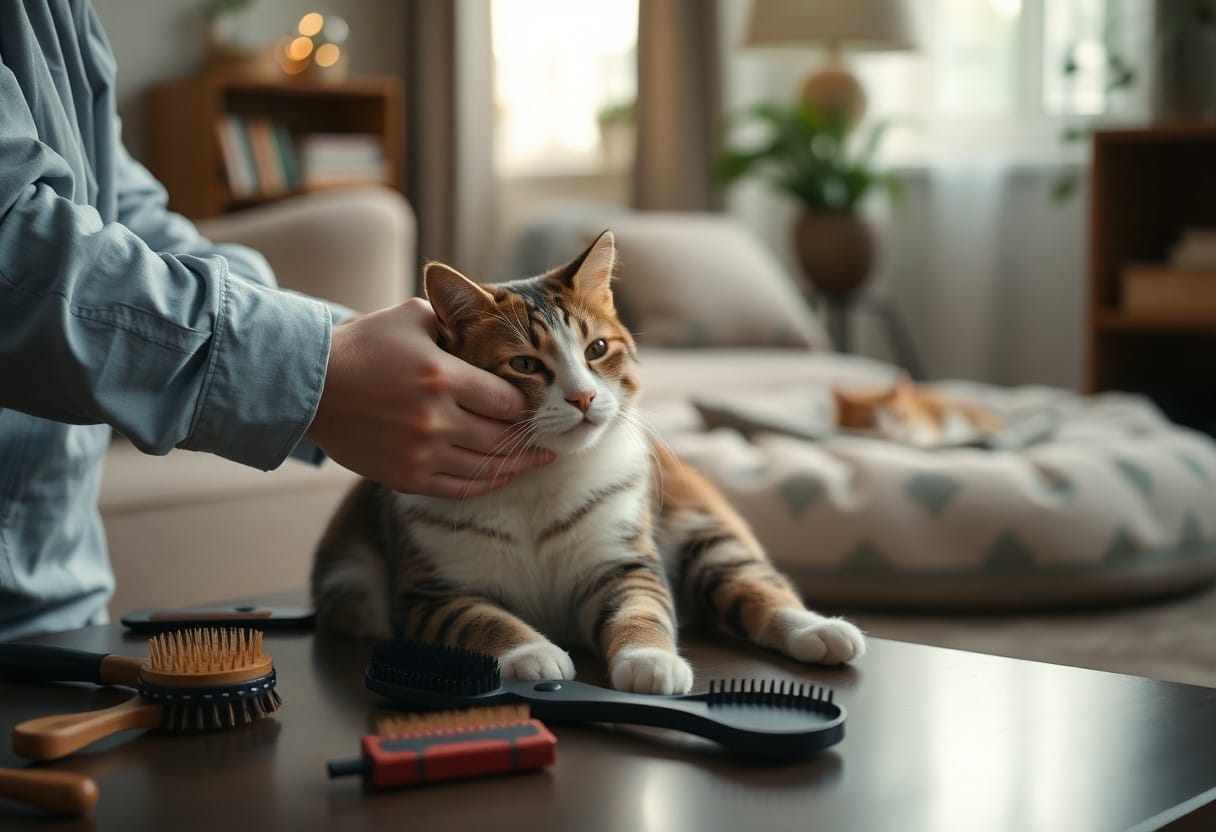
Essential Grooming Tools
After gathering the right grooming tools, you will find that the experience becomes easier and more enjoyable for both you and your cat. Investing in quality products tailored for cats can enhance your grooming routine, helping to keep your feline friend clean, comfortable, and happy. The crucial tools you’ll need include brushes, combs, and nail clippers, among others, making it important to choose the best options for your specific pet’s needs.
Brushes and Combs
Around different types of coats, selecting the right brushes and combs is important for effective grooming. Long-haired cats benefit from slicker brushes to remove tangles and loose fur, while short-haired cats are best served with bristle brushes to remove dirt and shine their coat. A fine-toothed comb is also ideal for addressing any matting or knots. By using the appropriate tools, you promote a healthy coat while building trust with your cat during grooming sessions.
Nail Clippers and Other Tools
Tools like nail clippers and grooming gloves can make your grooming routine more efficient. Keeping your cat’s nails trimmed is crucial for their comfort and your household safety. A good pair of nail clippers designed specifically for cats can help you achieve this quickly and safely. Due to the sensitive nature of your cat’s paws, take care to avoid the quick, the pink area of the nail that contains blood vessels and nerves, as cutting into it can cause pain and bleeding. Other tools, such as grooming gloves, can also be beneficial in removing loose hair while bonding with your pet. Proper tools not only streamline grooming but contribute positively to your cat’s overall well-being.
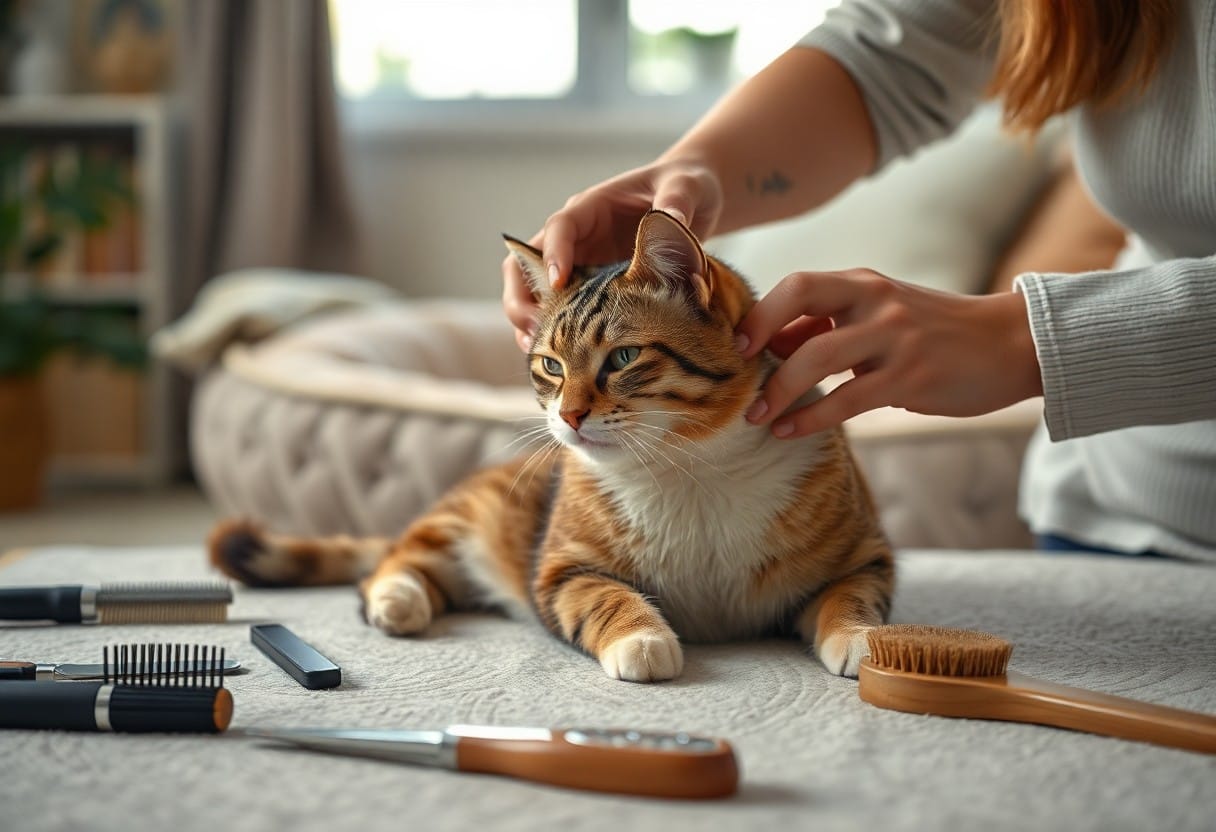
Steps for Effective Grooming
Keep your grooming routine consistent and relaxed to ensure a positive experience for both you and your cat. Start by setting aside dedicated time in a quiet space free from distractions. Use gentle touches and soothing words to create a calm environment. Establish a routine that includes brushing, checking for mats, and cleaning ears. Incorporate playtime and breaks to keep your pet engaged and comfortable. Regular grooming not only helps maintain your cat’s coat but also strengthens your bond.
Brushing Techniques
About brushing, utilize the right tools for your cat’s coat type. Use a wide-toothed comb for long-haired felines and a bristle brush for short-haired companions. Start from the head and work towards the tail, removing any tangles gently. Brush in the direction of hair growth and pay special attention to underarms and tails. Your touch should be light yet effective to maintain comfort and encourage loyalty and trust.
Bathing Tips
Any bathing session can be made less stressful with proper preparation. Gather all necessary supplies like a non-slip mat, shampoo formulated for cats, and towels before you begin. Consider using lukewarm water in a tub or sink, and always communicate softly to keep your cat at ease. Use minimal water to avoid overwhelming your pet, focusing on areas that need soaping up. Rinse thoroughly and dry gently.
- Non-slip mat: helps your cat feel secure
- Shampoo for cats: ensures a safe wash
- Soft towels: are vital for drying
Perceiving the process as a reality can help shape a calm and pleasant experience.
Understanding the nuances of bathing your cat can lead to smoother sessions. Cats naturally groom themselves, so you may not need to bathe them often. However, if they have become dirty or smelly, you can do it occasionally. Use warm water and never expose your cat to hot temperatures. Make sure to use feline-friendly shampoo, as human products can be harmful due to their pH imbalance. Allow your cat to experience the water gradually to minimize fear.
- Warm water: keeps your cat comfortable
- Feline-friendly shampoo: prevents skin irritation
- Gradual exposure: reduces anxiety during bathing
Perceiving bathing as a bonding experience can transform the activity into a routine that both of you look forward to.
Handling Sensitive Cats
Not all cats enjoy being groomed, especially sensitive ones that may react negatively to the experience. It’s imperative to approach these cats with understanding and patience. You should pay attention to their body language and adapt your grooming methods accordingly, creating a safe and calming atmosphere that reduces stress for both you and your feline friend.
Easing Anxiety
Along with selecting a comfortable grooming space, you may find that incorporating calming music or soft, gentle strokes can ease your cat’s anxiety. You can also try to establish a routine to provide your cat with predictability, making each grooming session a less intimidating experience. Using familiar scents or blankets can further enhance your cat’s comfort during this time.
Positive Reinforcement Strategies
Any time you groom your cat, using positive reinforcement can significantly improve their experience. Offering treats, praise, or affection during and after grooming sessions helps create a positive association with the process and encourages your sensitive cat to remain calm.
Further, integrating a system of positive reinforcement can transform grooming into an enjoyable activity for your cat. You can start by giving high-value treats when they stay calm or allow you to brush them. Gradually, as your cat becomes accustomed to grooming, you can introduce verbal praise and gentle petting as rewards. Ensuring that grooming sessions are brief and concluding them with a positive interaction will foster a more pleasant experience, ultimately leading to a cat that is more willing to cooperate in future sessions.
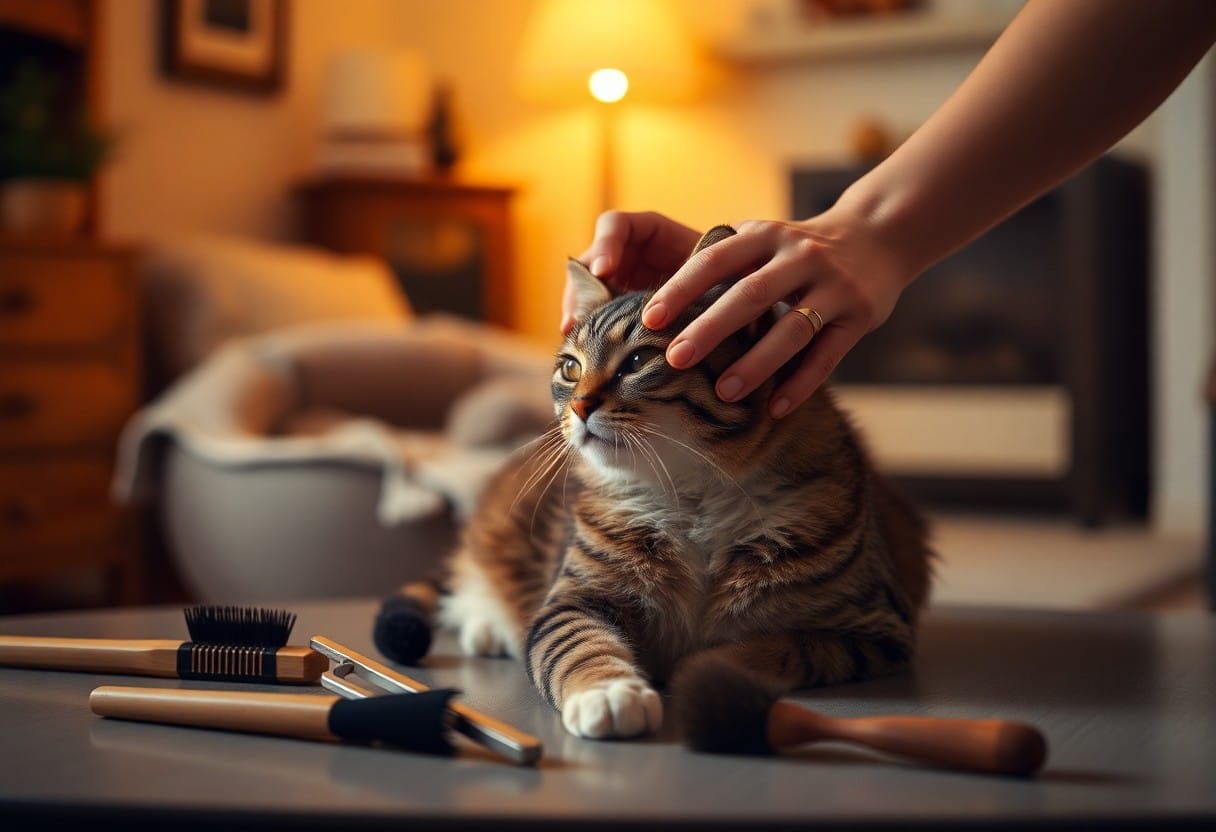
Routine Grooming Schedule
Now that you understand the importance of grooming, establishing a routine grooming schedule can significantly contribute to your cat’s well-being. By incorporating grooming into your regular routine, you create a safe space for your cat to feel comfortable and relaxed. Aim for consistency, whether that means daily, bi-weekly, or weekly sessions based on your cat’s needs. Gradually, you’ll build trust during grooming sessions, making the experience more enjoyable for both of you.
Frequency and Duration
On average, most cats benefit from grooming sessions lasting 10 to 20 minutes a few times a week. Long-haired breeds may require daily attention, while short-haired cats might need less frequent grooming. Pay attention to your cat’s coat condition and shedding patterns to determine the best frequency for your grooming schedule.
Adapting to Your Cat’s Preferences
Preferences can vary significantly between individual cats. Some may enjoy being brushed, while others might find it stressful. Observe your cat’s body language and vocalizations to gauge their comfort level during grooming sessions. Tailoring the experience to their liking is key to helping them relax.
Indeed, creating a positive grooming experience is all about adapting to your cat’s preferences. Experiment with different brushes, tools, and grooming techniques until you find what makes your feline friend feel comfortable. You may notice that certain areas of their body are more sensitive; approach those spots gently or skip them altogether if necessary. Consistency paired with responsiveness to their needs can turn grooming into a shared bonding time, instead of a chore, ultimately leading to a healthier, happier cat.
Final Words
Taking this into account, gentle grooming can transform the grooming experience for both you and your cat. By following these tips, you can create a calm environment that encourages trust and comfort. Choose the right tools, establish a routine, and use positive reinforcement to make grooming sessions enjoyable. Your cat will not only look their best but also appreciate the quality time spent together, strengthening your bond. With patience and practice, grooming will become a rewarding part of your cat care routine.
FAQ
Q: How can I create a calming environment for my cat during grooming sessions?
A: To create a calming environment for your cat during grooming, start by choosing a quiet and comfortable space free from distractions. Use soft lighting and play soothing music to help set a tranquil mood. You can also lay down a soft blanket or a cat bed where your cat feels secure. Ensure you have all your grooming tools ready to avoid unnecessary interruptions. Consider using treats or toys to associate grooming with positive experiences, helping to reduce anxiety.
Q: What grooming tools are recommended for at-home grooming sessions?
A: For effective at-home grooming, it’s necessary to have a variety of tools tailored for your cat’s coat type. A high-quality brush is vital; use a slicker brush for long-haired cats and a bristle brush for short-haired cats. Additionally, consider having a comb on hand to tackle tangles or mats. Nail clippers or a nail grinder are important for paw care, and a gentle cat-specific shampoo can be valuable for baths if necessary. Ensuring these tools are comfortable for both you and your cat will enhance the grooming experience.
Q: How can I help my cat feel more comfortable with grooming over time?
A: To help your cat become more comfortable with grooming over time, start slowly and gradually introduce the grooming tools. Begin by gently handling your cat’s fur using your hands, then progress to short grooming sessions with a brush. Always praise your cat and offer small treats during and after the sessions to create positive associations with grooming. Regularly integrating grooming into your routine can help your cat acclimate to the process. If your cat shows signs of stress, take a break and try again later to ensure the experience remains enjoyable.
